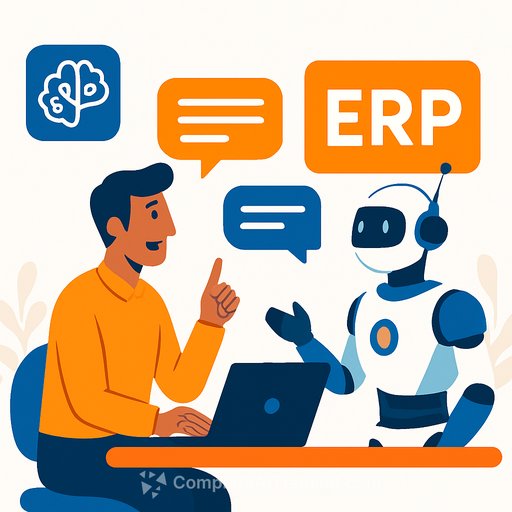Agentic AI pushes ERP from menus to conversations: what operations leaders need to know
Ramco Systems is betting on autonomous, agent-based AI to change how enterprises run daily operations. Instead of clicking through forms and static workflows, users ask the system to complete outcomes-and intelligent micro-agents do the work with minimal oversight.
Balaji R, Head of Core ERP at Ramco Systems, frames it simply: traditional menus give way to conversational execution coordinated by a central brain that manages many agents at once. For operations, this means fewer manual touchpoints, faster cycle times, and tighter control loops.
From menus to conversations
Agentic AI shifts ERP from forms and presets to intent and results. You state the objective; agents handle the steps-data entry, validations, cross-system checks, and even conditional decisions under defined policies.
Key difference from older automation: agents can analyze, predict, and act in real time. They don't just move data; they close loops.
From system of record to system of intelligence
Ramco's platform is moving to an AI-first, API-first model with a goal of fewer clicks and faster completion. Natural Language Processing sits on top of the ERP engine so teams can trigger tasks, not just fill forms.
Role-based hubs surface only what matters. Context-sensitive analytics bring the metric to the moment-inside the flow of work, not in a separate report silo.
Industry context, built-in
Ramco draws on decades across cement, textiles, and manufacturing within the Ramco Group. That domain depth shows up as workflow logic, constraints, and KPIs that reflect real plants, not generic templates.
Embedded analytics with BInGO
BInGO (Business Intelligence on the Go) offers 50+ pre-built dashboards, drag-and-drop analysis without code, and multi-source integration. The standout is AI-driven exception analysis that flags anomalies automatically.
By embedding analytics within ERP, teams can reduce reliance on external BI tools and cut the swivel-chair time between systems.
What this means for operations
- Agents complete tasks end-to-end based on policies and historical outcomes.
- Real-time monitoring reduces lag between event and action.
- Always-on interfaces keep processes moving across shifts and time zones.
- Teams shift from transactional work to exception handling and decision support.
Mid-market fit: modular and predictable
Ramco's modular rollout lets teams start with the biggest bottlenecks and scale as value proves out. Scope stays tight, costs track to benefits, and adoption doesn't overwhelm existing resources.
Adoption drivers in emerging markets
Growth in manufacturing, government-led digital programs, and the push for integrated local/global operations are accelerating ERP refresh cycles. E-invoicing mandates and portal integrations add urgency for standardized, API-led systems.
For context on e-invoicing standards and trends, see the OECD's guidance on electronic invoicing and tax digitization here.
Due diligence checklist for operations leaders
- Use cases: Prioritize high-volume, rules-heavy processes (AP coding, MRP exceptions, order promising, inventory reconciliations).
- Data readiness: Assess master data quality, event streams, and API availability.
- Guardrails: Approval thresholds, audit trails, rollback plans, and human-in-the-loop for material decisions.
- Security and compliance: SOC 2/ISO, data residency, vendor access boundaries, prompt/response logging, and redaction.
- Change management: Role impacts, training, and clear RACI for exceptions.
- Integration: ERP, MES, WMS, TMS, CRM, and government portals via APIs/webhooks.
- Cost model: Licensing, usage fees, data egress, and projected savings by process.
- KPIs: Cycle time, first-pass yield, exception rate, agent accuracy, and working capital impact.
- Governance: Model updates, drift monitoring, and versioned policies for agents.
For a pragmatic governance reference, review the NIST AI Risk Management Framework here.
90-day pilot plan
- Weeks 0-2: Pick one process and one metric that matter. Baseline performance. Define acceptance criteria and failure modes.
- Weeks 3-6: Connect data sources, set approval thresholds, run agents in shadow mode, compare to human outcomes, tune policies.
- Weeks 7-12: Limited production rollout with guardrails. Train users. Measure impact weekly. Lock in gains and plan the next process.
Risks to manage
- Decision errors: Use confidence thresholds and human review for high-value transactions.
- Over-automation: Keep deterministic fallbacks for critical paths and cutovers.
- Drift: Monitor accuracy, revalidate prompts/policies, and retrain on new data.
- Sprawl: Centralize agent catalogs, ownership, and access controls.
Bottom line for operations
Agentic AI can compress cycle times and reduce manual effort if you pair it with clean data, clear policies, and tight governance. Ramco's approach-conversational execution, embedded analytics, and industry depth-shows how this can work in practice.
If your next ERP move is on the horizon, start with one process, measure real outcomes, and scale what proves value. For structured upskilling on AI in operations, explore courses by job and the latest AI course tracks here.
Your membership also unlocks:






